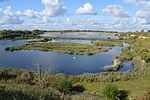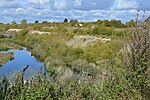Tring Reservoirs
Canal reservoirs in EnglandHerts and Middlesex Wildlife Trust reservesReservoirs in BuckinghamshireReservoirs in HertfordshireSites of Special Scientific Interest in Buckinghamshire ... and 3 more
Sites of Special Scientific Interest in HertfordshireTringUse British English from August 2017

Tring Reservoirs is a group of four reservoirs close to Tring on the border of Hertfordshire and Buckinghamshire, England. Their purpose is to feed the Grand Union Canal.The four reservoirs are: Startops End, Marsworth, Tringford and Wilstone. The first three reservoirs adjoin each other, separated only by paths and roads; the fourth, Wilstone Reservoir, is a short distance to the west, close to the village of Wilstone. The reservoirs are a 106.5-hectare (263-acre) biological Site of Special Scientific Interest managed by the Herts and Middlesex Wildlife Trust.
Excerpt from the Wikipedia article Tring Reservoirs (License: CC BY-SA 3.0, Authors, Images).Tring Reservoirs
Tringford Road, Dacorum Tring Rural
Geographical coordinates (GPS) Address Nearby Places Show on map
Geographical coordinates (GPS)
| Latitude | Longitude |
|---|---|
| N 51.813 ° | E -0.668 ° |
Address
Tringford Road (Tring Ford Road)
Tringford Road
HP23 4LH Dacorum, Tring Rural
England, United Kingdom
Open on Google Maps









